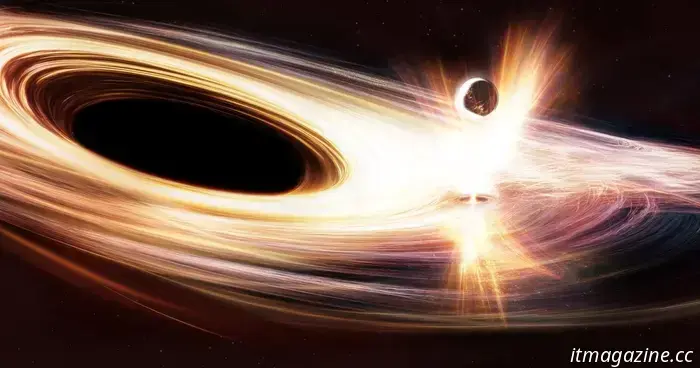
Astronomers are captivated as an active black hole stirs and begins to consume matter.
This artistic representation depicts the process that may be responsible for the intense X-ray emissions observed from a recently reactivated black hole called Ansky.
At the core of nearly every galaxy lies a colossal entity: a supermassive black hole that can have a mass tens of thousands or even millions of times that of our sun. However, not all of these massive entities behave identically; some are calm and inactive, while others exhibit active behavior, rapidly consuming surrounding material. Presently, astronomers are closely monitoring a black hole that is "waking up," transitioning from an inactive phase to an active one as it begins to consume nearby matter.
The black hole at the center of galaxy SDSS1335+0728, situated 300 million light-years away, had remained inactive for decades, consuming little matter while in a dormant state. Recently, however, it abruptly became luminous, emitting X-rays as it awakened and began to feed on nearby material.
Astronomers have been tracking this black hole utilizing a telescope from the European Space Agency (ESA) called XMM-Newton, along with NASA's NICER, Chandra, and Swift telescopes.
"This unusual occurrence offers astronomers the chance to observe a black hole's activity in real time, using X-ray space telescopes," explained lead researcher Lorena Hernández-García from Valparaiso University. "This event is defined as a quasiperiodic eruption, or QPE. QPEs are transient flaring phenomena, and this marks the first time we have detected such an event from a black hole that appears to be awakening."
The bright core of this galaxy has been nicknamed "Ansky," and astronomers have been monitoring it since 2019. The cause of a black hole's activation remains unclear, making this a rare chance to study a black hole emerging from dormancy, with this case being particularly powerful.
"The X-ray emissions from Ansky are ten times longer in duration and ten times more luminous than those typically observed in a QPE," stated fellow researcher Joheen Chakraborty from the Massachusetts Institute of Technology. "Each of these outbursts releases a hundred times more energy than we have documented elsewhere. Ansky's events also exhibit the longest interval recorded, approximately 4.5 days. This challenges our models and current understandings of how these X-ray bursts are produced."
Black holes usually emit X-rays due to the intense heat generated by matter swirling in their accretion disk. However, these energy bursts are so intense that they indicate an alternative scenario may be unfolding: possibly indicating that an object, such as a star or a smaller black hole, is being drawn into the accretion disk, producing a shock wave in the surrounding matter and resulting in an X-ray burst.
The researchers aim to gather more insights by continuing to observe Ansky's evolution over time. "For QPEs, we currently have more theoretical models than empirical data, and further observations are essential for fully grasping the situation," remarked ESA Research Fellow and X-ray astronomer Erwan Quintin.
"We previously believed that QPEs originated from smaller celestial bodies being captured by significantly larger ones and spiraling towards them; however, Ansky's eruptions appear to tell a different tale."
The findings have been published in the journal Nature Astronomy.
***
Scientists are calling on public participation to help in the search for black holes, despite their ability to consume anything in proximity, including light. Black holes are incredibly dense and possess substantial mass, producing a gravitational pull that can be detected from light-years away. Nonetheless, the universe is vast, and researchers are hoping the public can assist in identifying more black holes for the sake of scientific discovery. The initiative, known as Black Hole Hunter, encourages the public to analyze data from NASA's Transiting Exoplanet Survey Satellite (TESS) to search for indicators of black holes. The technique employed, known as gravitational microlensing, involves observing variations in the brightness of stars over time to find signs that a black hole has momentarily passed in front of a star, bending its light. This approach may allow the project to detect black holes that would typically remain hidden.
***
Researchers have recently identified the furthest black hole yet observed in the X-ray spectrum, which possesses distinct characteristics that may provide insight into the formation of massive black holes. At the center of most galaxies lies a supermassive black hole, which can be hundreds of thousands to billions of times more massive than our sun. The connection between these enormous black holes and galaxy formation is still not fully understood, raising questions about how supermassive black holes achieve such great masses.
***
A recent image captured by the Gemini South observatory illustrates the chaotic aftermath of a merger between two spiral galaxies that occurred 1 billion years ago, highlighting a surprising scenario where two supermassive black holes coexist at the center of a single galaxy. Although it may be hard to envision, entire galaxies can collide within the vast





Other articles
 NYT Mini Crossword today: solutions for Friday, April 11
The NYT Mini crossword may be significantly smaller than a standard crossword, but it's still quite challenging. If you're having trouble with today's puzzle, we have the solutions for you.
NYT Mini Crossword today: solutions for Friday, April 11
The NYT Mini crossword may be significantly smaller than a standard crossword, but it's still quite challenging. If you're having trouble with today's puzzle, we have the solutions for you.
 A 44% discount brings the price of this 17-inch HP laptop down to under $500.
The HP Laptop 17t, equipped with a 17.3-inch display and a 13th-generation Intel Core i5 processor, is currently available at a 44% discount from HP, amounting to a savings of $380.
A 44% discount brings the price of this 17-inch HP laptop down to under $500.
The HP Laptop 17t, equipped with a 17.3-inch display and a 13th-generation Intel Core i5 processor, is currently available at a 44% discount from HP, amounting to a savings of $380.
 NYT Strands for today: clues, spangram, and solutions for Friday, April 11.
Strands offers a challenging twist on the traditional word search from NYT Games. If you're having difficulty and can't figure out today's puzzle, we've got assistance and clues for you right here.
NYT Strands for today: clues, spangram, and solutions for Friday, April 11.
Strands offers a challenging twist on the traditional word search from NYT Games. If you're having difficulty and can't figure out today's puzzle, we've got assistance and clues for you right here.
 Google's Gboard may soon include a meme generator powered by AI.
Google is working on an AI meme generator. Whether this is good or bad news depends on your age.
Google's Gboard may soon include a meme generator powered by AI.
Google is working on an AI meme generator. Whether this is good or bad news depends on your age.
.jpg) 3 PlayStation Plus games to enjoy this weekend (April 11-13)
As the excitement for the new console begins to fade, PlayStation Plus offers an impressive selection of games to provide you with something new to enjoy this weekend.
3 PlayStation Plus games to enjoy this weekend (April 11-13)
As the excitement for the new console begins to fade, PlayStation Plus offers an impressive selection of games to provide you with something new to enjoy this weekend.
Astronomers are captivated as an active black hole stirs and begins to consume matter.
A massive supermassive black hole is starting to consume matter, and this telescope is observing it.
